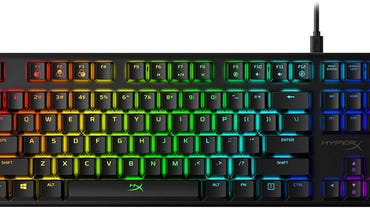HyperX Alloy Origins Core keyboard review: Amazing build, terrible keycaps — but still worth a look | ZDNet
HyperX has found itself an enviable niche in the PC gaming peripheral space as a maker of surprisingly high-quality products that won’t empty your wallet. From its Cloud-branded headphone line, to its Haste gaming mice, the company consistently nails the budget to mid-range market across various product categories.
HyperX’s Alloy keyboard line might not have the same level of recognition as the aforementioned series. But, the entry we’re looking at today goes a long way toward cementing the company’s position in the mechanical gaming keyboard space. It incorporates a rock-solid, fully-aluminum outer case, bright and saturated RGB lighting, and aesthetics that could fit in just as well as the office as at your gaming desk.
Unfortunately, all of this is held back by some problematic holdovers that other gaming peripheral brands have long since left behind, including low-quality keycaps, design decisions that pointlessly limit customizability, and occasionally frustrating companion software. Read on to find out how this handful of drawbacks took what could have been one of the best gaming keyboards we’ve ever tested and turned it into a mixed bag, and why you might still want to give it a chance.
Like
- Rock-solid aluminum case
- Sturdy, stable, and highly-adjustable feet
- Extreme keymapping flexibility of NGENUITY software
- User-replaceable USB-C cable
Don’t Like
- Some of the worst keycaps I’ve tested in a long time
- Built-in USB-C port is needlessly restrictive to aftermarket cables
- NGENUITY lighting settings are unintuitive and frustrating
Configuration and features
The HyperX Alloy Origins Core is a tenkeyless keyboard. This means it has a full set of arrow keys and text editing keys like Page Up/Down, Home/End, and Insert/Delete, but lacks the right-side number pad included on full-sized boards.
In addition to this size, HyperX offers the smaller HyperX Alloy Origins 65, which keeps the arrow keys and a few text editing keys, and the even smaller HyperX Alloy Origins 60, which skips everything but the main alphabet and number keys. Its current gaming keyboard lineup also includes a trio of larger, full-sized entries: the HyperX Alloy Origins, Alloy Core RGB, and Alloy Elite 2.
The Alloy Origins Core is a wired keyboard with a detachable, 6-foot USB-A to USB-C cable that uses a braided outer covering. It features an “aircraft grade” aluminum outer case, and includes three-way adjustable feet that can leave the board at a flat three-degree tilt, or raise it to either seven or 11 degrees.
HyperX offers this model with three switch choices: HyperX Blue (clicky), HyperX Red (linear), and the version included in our test board, HyperX Aqua (tactile).
More: Pulsefire Haste review: An ultra-lightweight mouse for work and play
While HyperX chose to stick with the traditional blue color for its clicky switches and red color for its linear option, it eschewed the typical brown coloration for tactiles in favor of the unique aqua-colored stems.
You can check out more in-depth coverage of each of these switch types, and a whole lot more, in our full guide to mechanical keyboards. But, for the purposes of this review, we’ll be sticking to the HyperX Aqua switches when we cover this board’s performance later on.
Each switch also includes a single RGB LED for keycap lighting. Each of these can be individually set to any color of your choice within HyperX’s NGENUITY software. The board also supports several animated lighting patterns, including reactive patterns that are triggered with each keypress. You can see all of the default options shown off in our demonstration and sound test video below
In addition to being able to change the color of each key, the functionality of each key can also be changed in the NGENUITY software. The Alloy Origins Core lacks any dedicated macro keys, but any existing key on the board can be mapped to any standard keypress, a variety of media playback and volume controls, and system functions. Users can also set up their own macros, or use one of the pre-defined options provided by NGENUITY.
Build quality and general performance
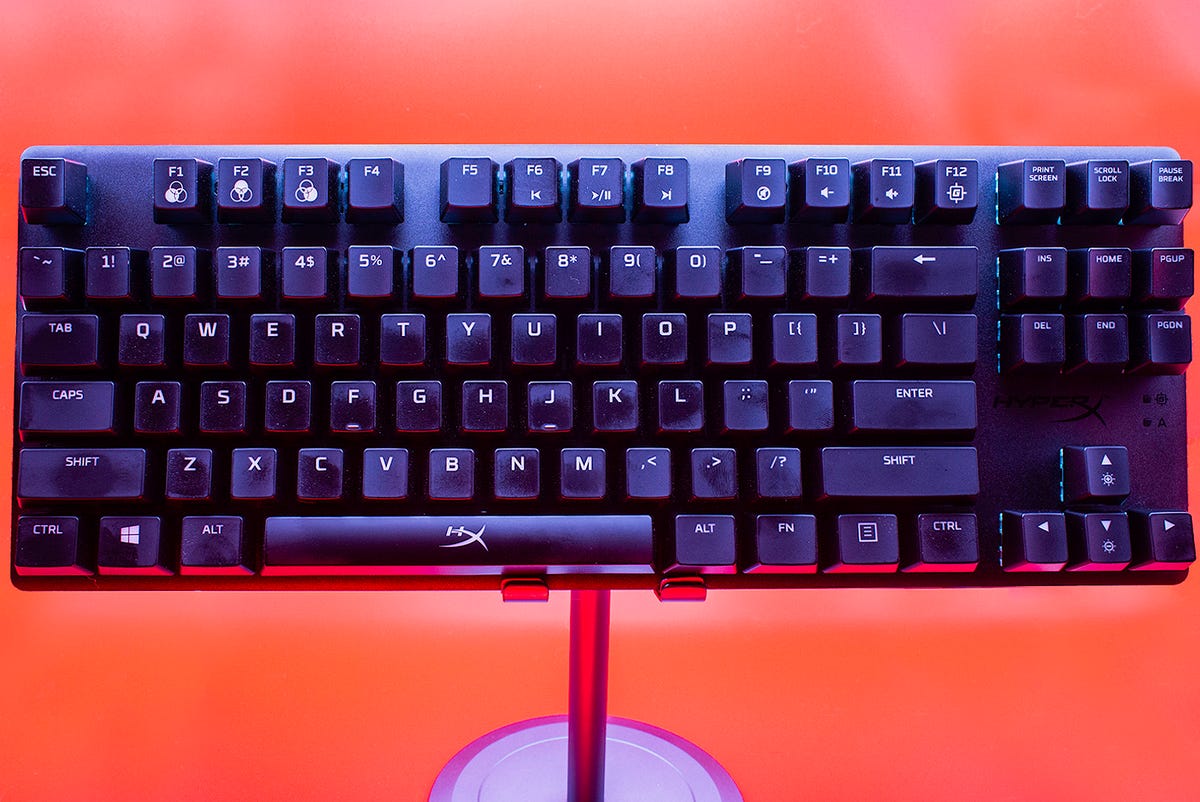
Take a close look at this shiny spots and smudges. We’ll be talking about those in a bit…
Michael Gariffo
The case
The HyperX Alloy Origins Core’s outer case is one area where it absolutely punches above its weight class. As soon as I took it out of its box I was struck by how solid and pleasantly weighty the board felt. Taking a closer look I found an outer shell that was precisely fabricated, with a textured finish that both repelled fingerprints and provided a pleasant feeling anytime my palms or wrists made contact during typing.
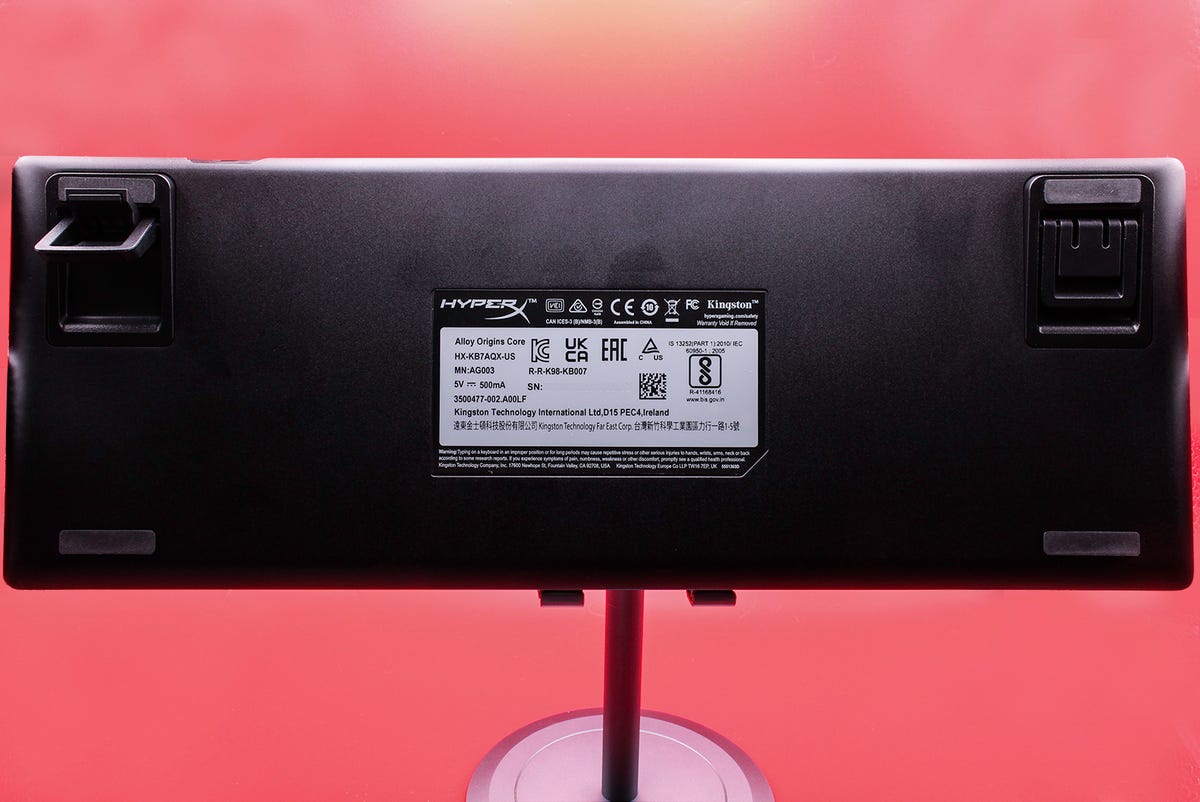
The dual-height feet are partially unfolded on the left and folded on the right.
Michael Gariffo
The included three-way adjustable feet provide a full range of typing angles, snap into place with a confidence-inspiring “thunk” and held the board perfectly stable on hard desktops and softer desk mats throughout my testing.
More: The 5 best mechanical keyboards: From mini to macros
The USB-C port for the included, replaceable cable also provided a satisfying feeling when connecting or disconnecting the included cable or any of the custom cables I tested it with. While most of the aftermarket cables I attempted to use worked just fine, a few with a larger casing on their USB-C connectors couldn’t quite reach into the depression HyperX chose to situate the port in.
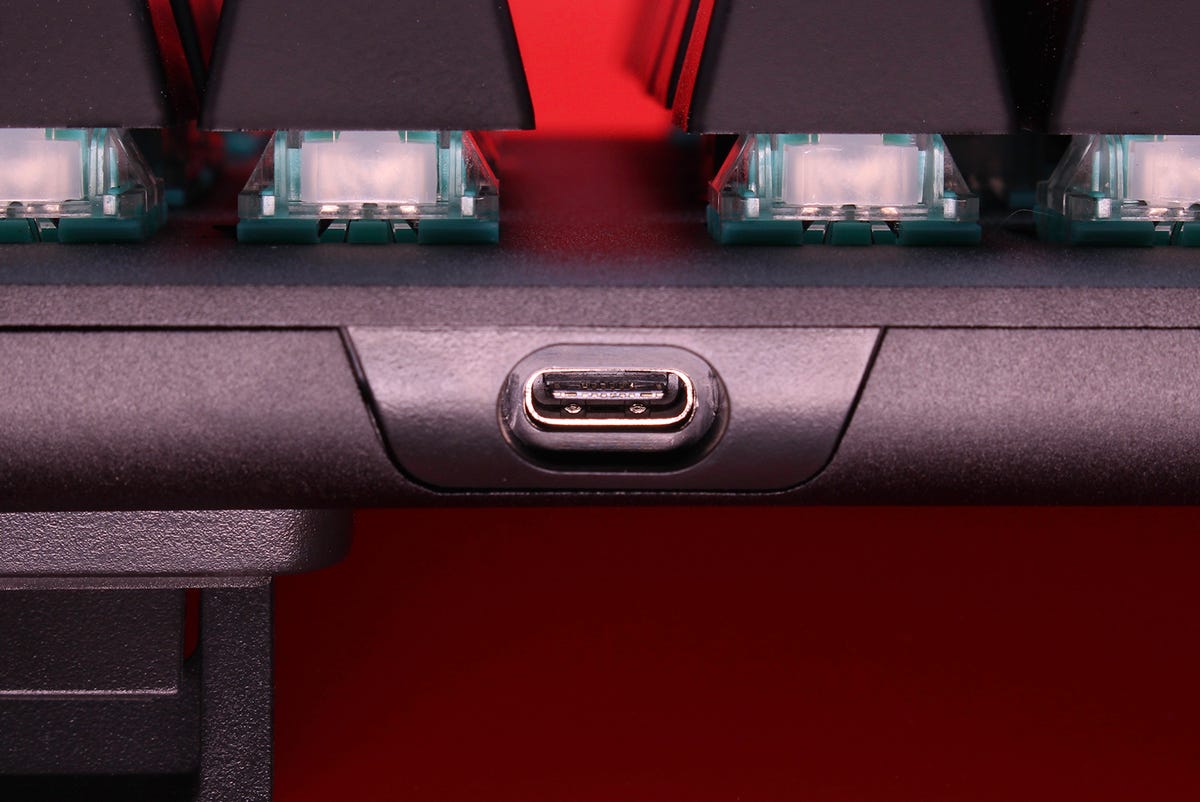
That inset area is just a bit too tight for a few cables I tried.
Michael Gariffo
The company’s decision to make its cable replaceable was definitely a wise one at a time when custom cables with coils, fancy connectors, and flashy color schemes are growing ever-more popular. But a flush-mounted port would have been a better choice for maximum flexibility.
The switches
HyperX’s Aqua tactile switches feel very similar to many other brown tactiles, including the original Cherry MX Browns and clones from Kailh and Gateron. I will say they are on the smoother end of the spectrum, lacking any of the “gritty” feeling some brown switches can produce. Instead, the Aqua switches offer a smooth, well-defined tactile bump that engages about mid-way through the key’s throw.
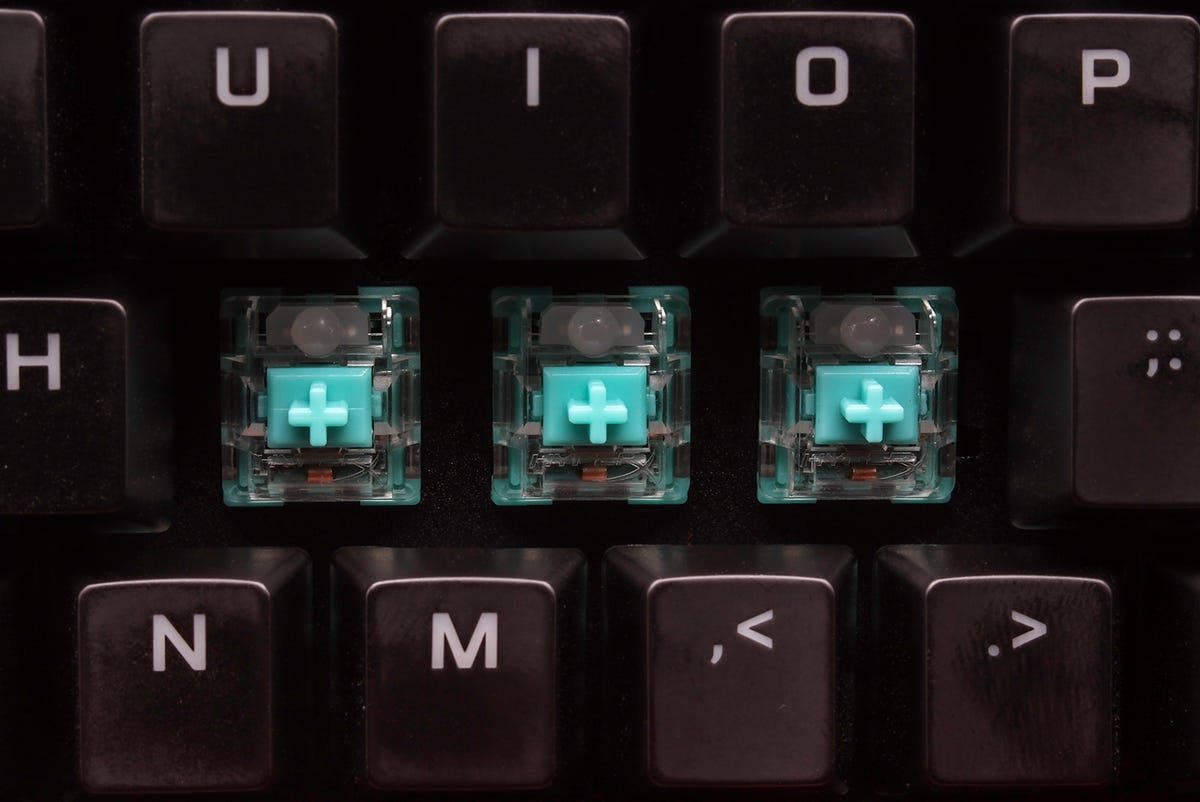
Michael Gariffo
Despite the fact that I personally prefer to type on linear switches, I found that I typed perfectly well on the Aquas, adjusting to them almost instantly. My typing speed tests on this board were almost identical to my daily driver board within minutes of initially sitting down with it. I also appreciated the mix of speed and typo resistance provided by the tuning of the Aqua’s notable tactile bump and lightweight spring weighting.
More: Keychron K8 review: A satisfying, sub-$100 gateway to mechanical keyboards
All in all, they didn’t convert me to a tactile switch enthusiast, but they were among the best proprietary attempts at the genre I’ve ever tested, especially from a large-scale gaming peripheral maker.
The keycaps
This is where I ran into my biggest gripe with the HyperX Alloy Origins Core. While the case and switches provided a level of quality and performance I’d expect to find on a much more expensive board, the included keycaps were the exact opposite. The plasticky, rattly caps mirrored ones I’d have expected to on gaming keyboards back when they were seen as toys, rather than serious PC peripherals worthy of high-quality components.
The worst aspect of their surprisingly poor quality was the finish HyperX used. We’ve all had keyboards that eventually got unpleasantly shiny as we wore away at the texture on their keycaps. Companies have done various things over the years to combat this, including the use of plastics like PBT, adding rougher initial textures to their caps, and other methods of protection. HyperX appears to have skipped all of those.
Not only do the keycaps on the Alloy Origins Core pick up that unpleasant shine while using them, they do so almost immediately. I purposely used the board for a few minutes before taking the photos used throughout this piece. I also purposely left the very obvious fingerprints even that momentary use produced. In almost every shot, you can see well-defined prints, glossy smudges, and persistent shiny spots after an absurdly short amount of use. If having fingerprints all over your glossy electronics bothers you, avoid these keycaps.
More: The best gaming keyboards: All the hits and clicks
Thankfully, due to the nature of mechanical keyboards, caps are the easiest thing in the world to remove and replace. This means that you could potentially buy the budget-friendly Alloy Origins Core and use the money you save to purchase a better, inexpensive set of keycaps. The Matrix Keyboards set I’m using to write this review cost me all of $50, has been in almost non-stop use for about a year, and still shows almost no signs of wear and no shine whatsoever.
Luckily for HyperX, this relatively inexpensive fix for their board’s main deficiency means it’s still a completely viable option for those that like its excellent build quality and competent switches. But, I can’t help but wish the company had spent just a bit more time and resources on nailing their keycaps the way they did the rest of the board’s components.
Gaming and lighting performance
For the most part, what makes a good general-purpose keyboard also makes a good gaming keyboard. That’s true in this case. This solid build quality and well above average tactile switches in our test unit provided a precise, responsive, and satisfying tool for games ranging from FPS (first-person shooter) titles to MMORPGs.
More: Razer Pro Type Ultra, Click Mini, and Glide XXL review: Gaming the office system
The lightweight 45g actuation force and relatively high 1.8mm actuation point of the Aqua switches were clearly tuned for gaming, allowing for rapid A/D strafing, split-section spell activations, and the kind of instant reactivity you want when escaping or initiating a lane gank in your favorite MOBA.
While the Alloy Origins Core might not have the plethora of keys offered by the full-sized Alloy Elite 2 or Core RGB, it still offers an excellent key selection in a small enough form factor to leave plenty of desk space for gamers that enjoy lower mouse sensitivities. This balance is further enhanced by the almost-limitless remapping options provided by the NGENUITY software.
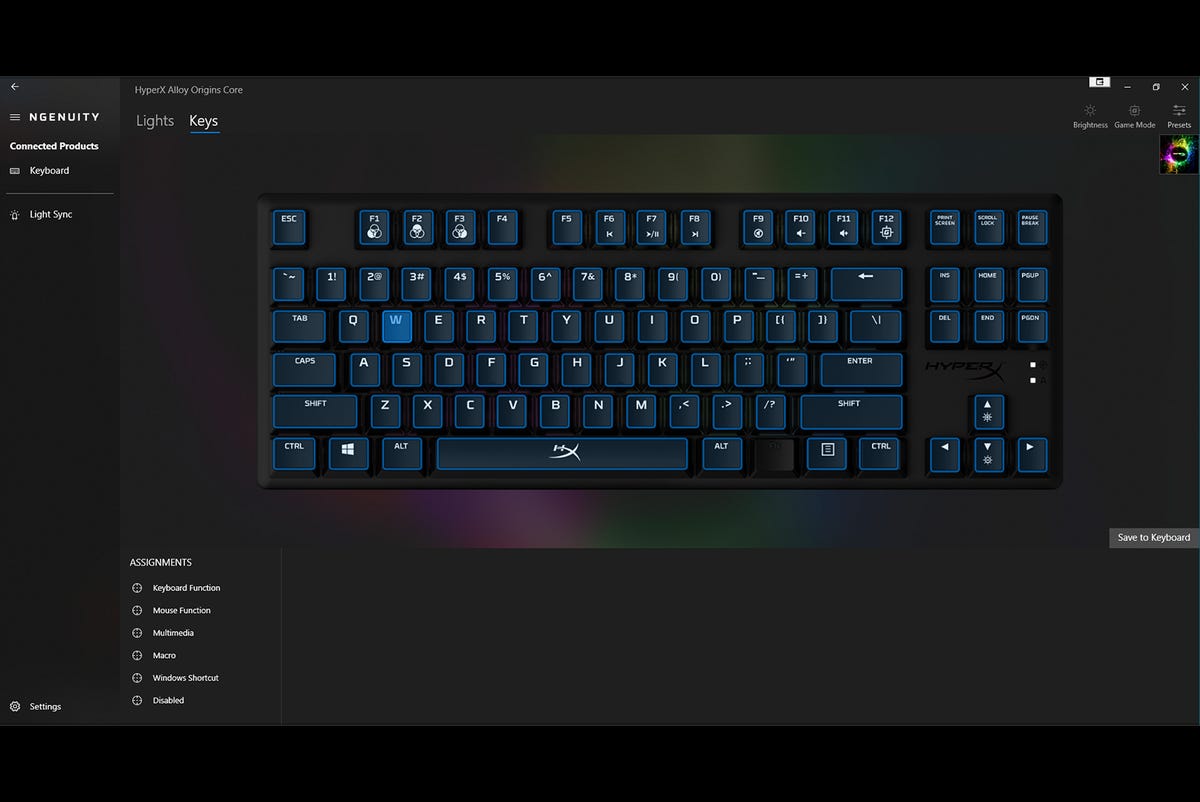
The main page within NGENUITY for remapping keys.
Michael Gariffo
Changing the function of a key is as simple as selecting it from a digital representation of your board; choosing the keypress, media function, or macro of your choice; and saving any changes you’ve made to your board. This proved to be a godsend not only for games that required complex key combination inputs, but also for productivity tasks that required an equal level of complexity.
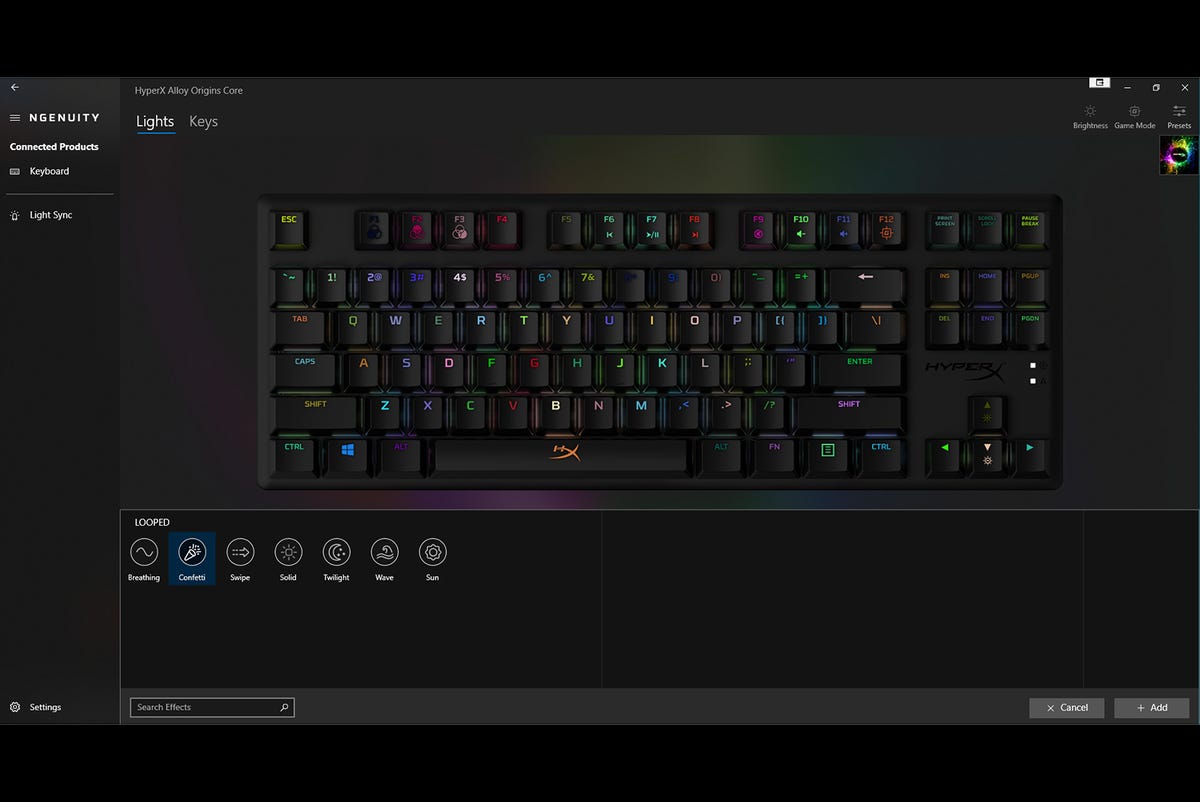
The page within NGENUITY for controlling full-board animated lighting patterns.
Michael Gariffo
I must note that the ease with which I could tweak the key mappings of the Alloy Origins Core did not carry over to the task of changing its lighting profiles. Switching between full lighting patterns and monochrome color schemes was a cinch. But, applying customized colors to individual keys was far more frustrating, with unintuitive interface methods and confusing software behaviors throughout the process. It was also far too easy to wipe out a long series of individual key color choices that had taken several minutes to set up with just one stray misclick.
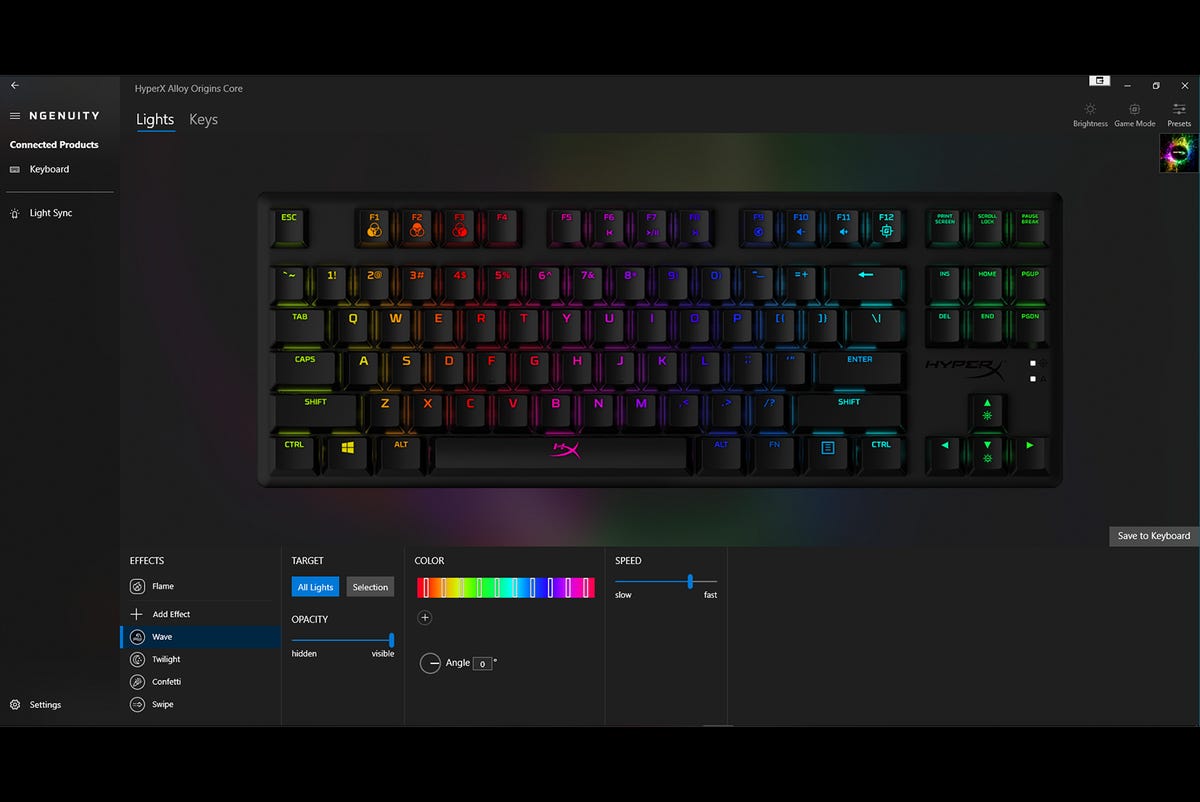
Just one page needed for the complex and often-frustrating task of adjust per-key lighting colors and patterns.
Michael Gariffo
Any PC gamer that’s been at it for more than a few days has likely run into frustrating companion software for their gaming peripherals. While HyperX NGENTUITY’s quirks around lighting controls are far from the worst I’ve dealt with, the companion platform could definitely use a few quality-of-life and ease-of-use improvements.
Thankfully, its flaws were more than made up for by the bright, highly-saturated lighting provided by the board itself. No color chosen for it ever looked washed out, even at maximum brightness settings. The built-in diffusers on each LED also provided a nice, even glow, and the option to disable the lighting entirely meant it was easy to turn a flashy gaming peripheral into a buttoned-up, serious business device when needed.
Wrap up
The HyperX Alloy Origins Core is a board that was very close to being a universal recommendation thanks to its exceptional case and near-perfect balance of size and customizability. Despite HyperX failing to stick the landing on its chosen keycaps, the board itself remains an excellent option, especially for those that were already intending to use a keycap set they own, or already intended to purchase a set down the road.
If you do plan to run the Alloy Origins Core in its stock form, be aware that you’re going to face shiny keys, slippery caps, and a rattly typing experience. All that said, adding a solid set of keycaps, even ones that cost only $45-$50, eliminates all of those issues and transforms this board into something that you’d easily expect to pay $150 to $200 for. Given the fact that this model often retails for as little as $70, the math still works out to a pretty excellent value when compared to the high-end offerings from Razer, Logitech, and other competitors.
More: The best budget gaming mouse: Affordable pro gameplay
Of course, if you prefer a better out-of-the-box option, other makers provide superior keycaps with switches that are just about equal to HyperX’s proprietary offerings. But, I’ve almost never seen a gaming-focused keyboard, at any price point, that can match the precise and sturdy feel of the Alloy Origins Core’s outer case. It legitimately rivals some mechanical keyboard cases that cost several times more than this entire keyboard, just for the empty case. If you’re looking for an inexpensive gaming keyboard with a solid foundation that’s still a bit of a fixer-upper, HyperX made just the board for you.
For all the latest Technology News Click Here
For the latest news and updates, follow us on Google News.

